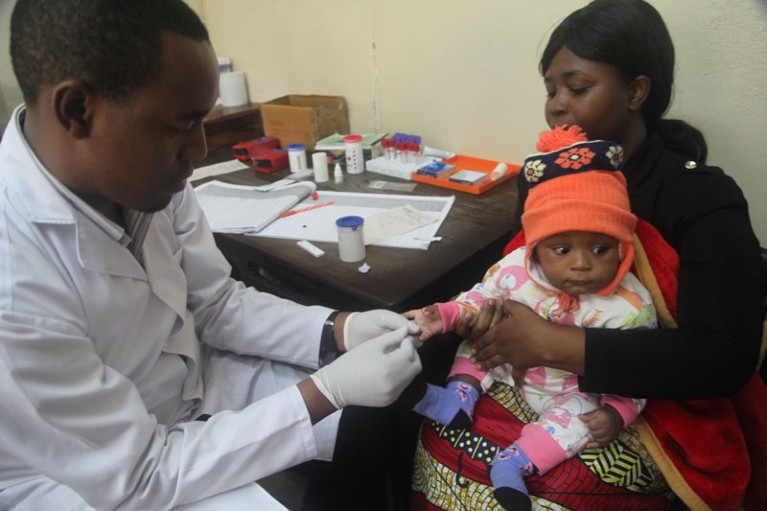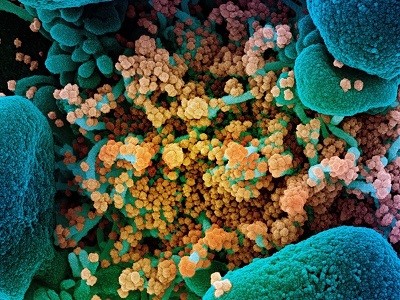
Testing and treatment for diseases such as malaria have dropped off as health-care services have pivoted to tackle COVID-19.Credit: Katy Migiro/Reuters
AIDS, malaria and tuberculosis (TB), three of the deadliest infectious diseases, together kill 2.4 million people every year, with TB alone responsible for 1.5 million deaths. And deaths from these diseases could almost double over the next year, according to the Global Fund to Fight AIDS, Tuberculosis and Malaria, a consortium of donors that funds treatments. The reason: coronavirus. It’s a horrifying prospect, and calls for an urgent action plan.
More than three months of lockdowns have prevented many people from accessing treatments for non-COVID infectious diseases; at the same time, new cases of these illnesses will have gone undetected. Although lockdowns are easing, it will take some time for health care to get back to normal, as authorities continue to prioritize COVID-19. Taken together, this is resulting in a surge of cases.
That’s why there needs to be a step change in funding for AIDS, malaria and TB prevention, treatment and research, and greater public awareness of the rising threat posed by infectious diseases. And researchers — particularly epidemiologists — must continue to refine the models that are alerting the world to this approaching catastrophe.
What the data say
Some 10 million people a year are infected with TB, and the majority of cases occur in Asia and Africa. Eight countries — India, China, Indonesia, the Philippines, Pakistan, Nigeria, Bangladesh and South Africa — account for two-thirds of infections.
One model, developed by researchers at the London School of Hygiene and Tropical Medicine, projects that there will be around 200,000 extra deaths from TB across China, India and South Africa between 2020 and 20241. A different model, from Philippe Glaziou of the World Health Organization’s TB programme, which has not yet been peer reviewed, projects an extra 190,000 TB deaths globally in 20202.
The data for AIDS and malaria are just as troubling. In 2018, nearly half a million people in sub-Saharan Africa died from AIDS-related illnesses. If access to antiretroviral therapies is disrupted for just six months, this number is projected to double in the coming year, according to modelling by the WHO and the Joint United Nations Programme on HIV/AIDS (UNAIDS) published in May, a high not seen in more than a decade.
Low- and middle-income countries face up to COVID-19
A study by researchers at Nigeria’s National Malaria Elimination Programme in Abuja and Imperial College London, published in Nature Medicine, predicts that 779,000 people are at risk of dying from malaria in sub-Saharan Africa in 2020 — more than double the number for 20193. Researchers at the WHO reached a similar estimate. They modelled the impact of COVID-19 on malaria in 41 countries under 9 scenarios. The worst case — a continuing suspension of campaigns to distribute insecticide-treated bednets, and a 75% drop in access to antimalarial drugs — would lead to 769,000 malaria deaths in sub-Saharan Africa this year, a mortality level not seen in 20 years.
Even more worryingly, these data are not the final word, because the models do not account for what will happen if lockdowns return or need to be extended. And the data will need to be revised again once the effects of coronavirus on TB detection and treatment are better known, along with the effects of infection with coronavirus and TB at the same time, known as co-infection. The coronavirus is now raging in countries such as India, Russia and Brazil, which have a high TB burden.
“I am super-nervous that the damage will be worse than what the models predict,” says Madhukar Pai, who directs the McGill International TB Centre in Montreal, Canada. On top of this, COVID-19 has created delays in non-COVID-19 research and drug-trial recruitment. “We need a damage-control plan,” Pai emphasizes. He is right.
Right now, with the total number of COVID-19 infections approaching 20 million and deaths standing at more than 700,000, we can’t say how bad the pandemic will get. But we can say that, without interventions, TB, AIDS and malaria are likely to take more lives.
Four proposals
Several things must now happen. First, hospitals and health authorities in affected cities and regions must recognize that AIDS, malaria and TB are surging again. In the case of TB, case detection — which has been affected by hospital testing facilities being diverted for COVID-19 — needs to be resumed quickly. It is possible for testing facilities to be shared for the two diseases. Some hospitals in the Asia–Pacific region are using the same equipment to run COVID-19 tests in the morning and TB tests in the afternoon — or vice versa. It is also possible to coordinate COVID-19 testing with rapid diagnostic testing for HIV and malaria.
Second, researchers must continue to refine their models using more real-world data. If Pai is correct — that cases and deaths will be higher than the models predict — then the models need to be improved.
Six months of coronavirus: the mysteries scientists are still racing to solve
Third, there is a need for public-information campaigns. Public, private and non-governmental organizations must alert people to the risks of rising levels of infectious diseases. Such campaigns will also go some way towards reassuring existing patients, as well as those who become unwell, that they need to seek — or continue — treatment.
Fourth, these campaigns cannot on their own keep surgeries and wards open, or equipment functioning. The resurgence of infectious diseases has created a greater demand for tests, treatments and research. All of these need more funding. In a June report, the Global Fund calculated that an additional US$28.5 billion is needed to ensure that HIV, TB and malaria programmes can continue to function, and that researchers can continue to develop common diagnostic tools — especially for TB and COVID-19. And this is just for the next 12 months.
The Global Fund is confident it can access $6 billion of this sum, on top of its annual spending, but it cannot raise the rest alone. Some of the fund’s largest international donors, such as the United Kingdom, are cutting back on science-aid funding, while at the same time prioritizing COVID-19 research and development.
If the usual channels for fundraising seem unlikely to deliver, alternative approaches should be tried, such as public events at which governments, companies and philanthropic organizations are invited to make funding pledges. The governments of richer countries do donate at such events, as seen in May, when a live COVID-19 donor conference organized by the European Union received €6.15 billion (US$7.2 billion) in pledges.
COVID-19 has turned the clock back years, if not decades, in the fight against infectious diseases. It is, of course, imperative that all measures possible are taken to protect people from coronavirus and to treat those who have become sick. But saving people from one infectious disease only to have them die of another is the last thing anyone wants.

 Low- and middle-income countries face up to COVID-19
Low- and middle-income countries face up to COVID-19
 Six months of coronavirus: the mysteries scientists are still racing to solve
Six months of coronavirus: the mysteries scientists are still racing to solve
 Why the World Bank ex-chief is on a mission to end coronavirus transmission
Why the World Bank ex-chief is on a mission to end coronavirus transmission
 What a US exit from the WHO means for COVID-19 and global health
What a US exit from the WHO means for COVID-19 and global health
 Coronavirus and COVID-19: Keep up to date
Coronavirus and COVID-19: Keep up to date





